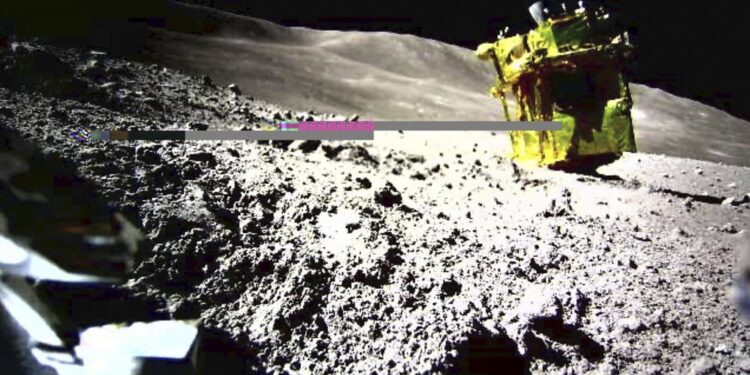This image provided by the Japan Aerospace Exploration Agency (JAXA)/Takara Tomy/Sony Group Corporation/Doshisha University shows an image taken by a Lunar Excursion Vehicle 2 (LEV-2) of a robotic lunar rover called Smart Lander to Investigate the Moon, or SLIM, on the moon. A Japanese lunar explorer, after making a historic “precise” moon landing last month, has also captured data from 10 lunar rocks, a much larger-than-expected job that could help find the clue to the Moon’s origin , his project manager said on Wednesday. , February 14, 2024. Credit: JAXA/Takara Tomy/Sony Group Corporation/Doshisha University via AP, File
An unmanned lunar spacecraft has captured and transmitted data analyzing 10 lunar rocks, a bigger-than-expected achievement that could help provide clues to the Moon’s origin, a Japanese space agency official said Wednesday.
For four days, the Smart Lander for Investigating Moon, or SLIM, which landed on the Moon last month, used its multi-band spectral camera to study rock composition and worked on examining lunar rocks, Shinichiro said , project manager of the Japan Aerospace Exploration Agency. Sakai.
The lunar mission is Japan’s first. The spacecraft made a historic precision landing on January 20, although it landed the wrong way up, its solar panels initially unable to see the sun, and it being powered off after brief communication with Earth. But on the eighth day, it began to function, allowing him to successfully reestablish communication with the JAXA command center on Earth.
A black-and-white photo transmitted shortly after SLIM was reactivated showed the lunar surface bumpy, including six rocks. The craft ultimately obtained data on 10 rocks in total, all of which were given dog breed names, such as “Akitanu,” “Beagle” and “Shibainu.”
“We hope that analyzing the rocks will lead us to the origin of the Moon,” Sakai said. By comparing the mineral compositions of lunar rocks and those on Earth, they could discover whether the rocks have any elements in common, he said. According to the “giant impact” hypothesis, the Moon was formed as a result of the Earth’s collision with another planet and the rotation of a smaller mass around them.
The JAXA team expected SLIM to study and analyze a single rock. Having data on 10 rocks was therefore cause for celebration, pushing the team to continue studying the origins of the Moon.
SLIM is currently “hibernating” in another lunar night which will last until the end of February. It remains unclear whether the probe and its spectroscope will survive the extremely cold nighttime temperatures and be able to “wake up” once sunlight returns.
The spacecraft had landed about 55 meters from its target, near Shioli Crater, a region covered in volcanic rock. This is the most precise landing compared to previous lunar missions which typically targeted flat areas at least 10 kilometers (6 miles) wide.
If the lander had not encountered a last-minute failure in one of the two main engines that caused a more difficult landing than expected, SLIM’s landing would have been estimated to be a few meters short of the target, JAXA said. .
SLIM carried two autonomous probes that were released just before landing, recording the landing, surroundings, and other lunar data. The two small probes had completed their mission recording SLIM’s early work and have since stopped operating.
The landing made Japan the fifth country in the world to reach the Moon, after the United States, the Soviet Union, China and India.
© 2024 The Associated Press. All rights reserved. This material may not be published, broadcast, rewritten or redistributed without permission.
Quote: Are we close to discovering the origin of the moon? Japanese space agency says it may now have clues (2024, February 14) retrieved on February 14, 2024 from
This document is subject to copyright. Apart from fair use for private study or research purposes, no part may be reproduced without written permission. The content is provided for information only.



